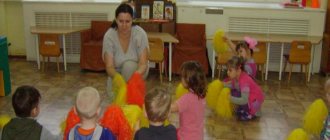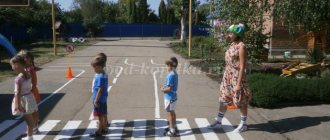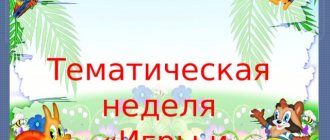Grosheva Ekaterina Alekseevna, MADOU “Kindergarten No. 14 “Solnyshko”, Staraya Russa, Starorussky district, Novgorod region. Theater is an excellent means of correction that occurs through play. Through theatrical play, the horizons expand, attention, imagination, and memory develop. Coherent speech skills increase and sound pronunciation improves, which is especially important for children 2-3 years old. Changes in motor skills and the emotional sphere are also noticeable, which indicates a correction of behavior in general.
Project " Theatre Week " in the 1st junior group.
M.E. Saltykov-Shchedrin argued that “of all the secrets that exist in the world, the secret of the doll is the most mysterious.”
Relevance of the project
Theater is an excellent means of correction that occurs through play. Through theatrical play, the horizons expand, attention, imagination, and memory develop. Coherent speech skills increase and sound pronunciation improves, which is especially important for children 2-3 years old. Changes in motor skills and the emotional sphere are also noticeable, which indicates a correction of behavior in general.
Objective of the project:
- Expand the ideas of children and parents about theater and theatrical games.
- Develop children's speech, promote the development of the ability to communicate with peers in a children's group.
- Moral education of preschool children, to form cultural values.
- Introduce new types of children's theater.
Tasks:
- Instill a love for theatrical action.
- Develop interest in various forms of representation.
- Develop the ability to follow the development of an action, maintaining attention until the end of the action.
- Teach children verbal and nonverbal means of communication.
- Introduce various types of puppet theater.
- Develop fantasy and imagination.
- Form emotional expressiveness of speech.
- Involve children and parents in organizing theatrical activities: decorate scenery, costumes, toys from ready-made elements.
Project participants: children of the first junior group, teachers, parents.
Project type: short-term, 1 week.
Planned result of the project:
- Forming children's interest in theater and fairy tales.
- Increasing speech activity in children.
- Creating a positive emotional communication environment between children, parents and teachers.
- Activation and enrichment of parents' pedagogical knowledge and skills.
- Development of creative abilities of children and parents in joint activities.
- Increasing trust in teachers.
- Development of a child’s personal qualities through theatrical activities.
- Development of children's creativity;
- Participation of parents in the educational activities of children in kindergarten.
- Involving parents in the production of attributes for the theater corner.
Proposed outcomes of the project:
- Activate children's vocabulary through theatrical activities and learning various fairy tales.
- Learn to treat books and the attributes of the theater corner with care.
- The ability to play in a friendly manner, not to quarrel, to develop communication and interaction of the child with peers and adults,
The final product of the project: Collective work of children with their parents to produce attributes for the theater corner (exhibition “Our Theater”).
PROJECT WORK PLAN.
Stage 1 – preparatory.
Activities of the teacher:
- During various conversations, increase the child’s interest in the theater.
- Find out what fairy tales parents tell at home. What fairy tales does the child know?
- Introduce children and parents to the topic of the project, indicate the significance of the chosen topic.
- Develop an action plan for project implementation. Select the necessary literature.
- Prepare visual aids for gaming and productive activities.
Children's activities:
- Independent activity of children in a corner of the theater.
- Look at illustrations on the topic.
- They examine the attributes in the corner of the theater.
Parents' activities:
- They watch the children.
- Questioning parents: “Theatre”.
Stage 2 – formative.
Activities of the teacher:
- Organizes conversations, educational games, and observations.
- Reading fiction (poems, fairy tales, songs).
- Provides assistance in the implementation of activities.
- Replenishment of the subject-development environment of the group.
- Selection of attributes for the game “What kind of fairy tales are there?”
Children's activities:
- They are trying to find solutions.
- They play in a corner of the theater.
- With the help of the teacher, “characters” are chosen for the game.
- Look at illustrations and books.
- Repeat actions and words from fairy tales after the teacher.
Parents' activities:
- Involving parents in the implementation of the project.
- Preparing a memo: “How to involve a child in theatrical activities?”
- Preparation of consultations: “Theatrical activities in kindergarten.”
- Decorating a corner for parents “Little Artists”.
Stage 3 – final.
Activities of the teacher:
- Analysis of the work done.
- Replenishment of the group's development environment.
- Replenishment of methodological literature.
- Design of an exhibition of children's works.
Children's activities:
- They are actively playing in the corner of the theater.
- Repeat the words of poems and fairy tales.
- They watch with interest the games of other children in the corner of the theater.
Parents' activities:
- Increasing the activity of parents in the life of the group.
- Competition for parents: “Our Theater” (making attributes for a corner of the theater with your own hands together with your children).
Conclusion at the end of the project.
In their daily work, children enjoy listening to poems and fairy tales, but they receive even greater pleasure from dramatizing fairy tales, showing a puppet show, or having children themselves participate in this fairy tale. Many children get used to the role of their favorite character and more and more often repeat his actions and words and thereby, without noticing it, stimulate speech activity.
Also, through theatrical activities, respect for each other is formed. Self-confidence develops. Children become more active and do not get lost in difficult situations.
Project implementation:
Educational area: Cognitive development.
Reading fairy tales: “Turnip”, “Ryaba the Hen”, “The Three Little Pigs”, “Kolobok”, “Zayushkina’s Hut”, “Teremok”.
Demonstration of tabletop puppet theater: “The Wolf and the Seven Little Goats.”
Educational field: “Speech development”.
Conversation: “Getting to know the theater”, “What kind of books are there?”
Learning a fairy tale by role: “The Three Little Pigs.”
Staging the fairy tale: “The Three Little Pigs” using a finger theater. Speaking tongue twisters.
Exercises to develop intonation expressiveness.
Games “Give me a word.”
Educational field: Social and communicative development.
Staging the fairy tale: “Turnip”, “Rock Hen” using a wooden theater.
Didactic game: “Vegetable or fruit”, “Collect eggs”.
Organization of the corner: “Hospital for books.”
Educational field: Artistic and aesthetic development.
“Kolobok”, “Hut for the Little Bunny”, “Cabbage for Kids”, “Theater Mask”, etc.
Singing O. Emelyanova’s song “Song about the Theater.”
Decoration of scenery and costumes.
Production of attributes for theatrical activities.
Educational field: Physical development.
Physical school, "Pinocchio", "Airplane".
Outdoor games: “Catch up with the bun,” “Fox with a rolling pin,” “The giraffe has spots...” “Hare and wolf.”
Bibliography:
1. Koldina D.N. “Sculpting and drawing with children. Class notes." - M.: Mosaic - Synthesis, 2008.
2. Efanova Z.A. “Knowledge of the objective world: comprehensive lessons.” /author – comp..- Volgograd: Teacher, 2013.
3. Makhaneva M.D. "Theatrical activities in kindergarten." 2003
4. Artyomova L.V. "Theatrical games for preschoolers." 1991
5. Alyabyeva E.A. "Themed days and weeks in kindergarten." 2006
Finger Theater
Author:
Rukan Natalya Valerievna,
teacher
second qualification category
MADO kindergarten No. 73 in Tyumen
Finger theater is a set of character figures that are put on a separate finger. These can be just individual dolls, animals, some objects for staging a fairy tale, or well-known characters from our favorite Russian folk tales. The Finger Theater is a unique opportunity to place a fairy tale on the palm of a child, in which he can take the role of any hero. A child can put any character on his finger and play. It is very important, when playing, to address the child, including him in the game. Theater is also an excellent speech and sensory-motor simulator. Dolls develop the mobility of the fingers of both hands, help master the speech of characters, help develop vocabulary and activate speech functions.
The finger theater is intended for children from 3 to 7 years old.
Goal: to develop fine motor skills of the hands in combination with speech; development of communicative abilities of preschool children in the process of finger theater.
Objectives: Teach children to act out small plays, skits, fairy tales using finger theater;
Develop: speech, thinking, memory, attention, creative imagination; enrich vocabulary;
Evoke positive emotions; instill a sustainable interest in the theater;
Description : knitted, sewn hero dolls, decorations.
Preparation: Set up the scenery, assign roles.
Variability of use:
-Learning nursery rhymes;
-Dolls can be used for acquaintance and learning to count (for example, in the fairy tale “Teremok” a mouse, a frog, and a hare began to live together, then a fox came and there were four of them); to get acquainted with the characters and plot of a fairy tale, to get acquainted with the concepts of “right - left”, “next to each other”;
- Acting out fairy tales: “Turnip”, “Teremok”, “Kolobok”, “Ryaba Hen”...;
-Come up with your own fairy tale;
-Guess the hero;
- “Who says what” (onomatopoeia);
- “The world of emotions” (sadness, joy, anger, surprise);
- “Name what color is the hero?” (gingerbread man - yellow, fox - orange, mouse - gray).
Finger theater and games with fingers develop the child’s brain, stimulate the development of speech, creativity, and imagination of the baby. Simple movements help to remove tension not only from the hands themselves, but also to relax the muscles of the whole body. They can improve the pronunciation of many sounds. The better the fingers and the entire hand work, the better the child speaks.
Dear teachers and parents - participants of the exhibition!
On June 2, 2015, a solemn ceremony of awarding the winners of the regional methodological exhibition “Modern educational environment of kindergarten and family” took place at the information and exhibition complex of the Tyumen Regional Duma. Details >>>
From June 8 to June 10, 2015, teachers from Tyumen received certificates of exhibition participants and multimedia albums with the full version of the exhibition at the Grant Center for the Development of Creativity for Children and Youth at the address: Profsoyuznaya St., 52. tel. for inquiries: 685-321,
June 9, 2015 Diplomas, certificates and gifts were sent to the winners and participants of the Exhibition of the south of the Tyumen region, Yamal-Nenets Autonomous Okrug and Khanty-Mansi Autonomous Okrug-Yugra by registered parcel post to the address of the preschool educational institution. Details >>>
Share
Project in the second early age group. Theatrical activities in kindergarten
Project for preschoolers 2-3 years old “We play theater”
Type of project: educational - creative. Implementation period: short-term project (1 month). Project participants: children, teachers, parents. Age of project participants: first junior group. Explanatory note Theatrical activities are one of the most effective ways to influence children, in which the principle of learning is most fully and clearly manifested: learn by playing. Theatrical games are the most important factor stimulating the development of coherent speech in children. They stimulate active speech by expanding vocabulary and improving the articulatory apparatus. The child learns the richness of his native language and its means of expression. Speech is not only a means of communication, but also a tool of thinking, creativity, a carrier of memory, information, etc. Expressiveness of speech develops throughout preschool age: from involuntary emotional - in children, to intonation speech - in children of the middle group and to linguistic expressiveness speech - in children of older preschool age. For the development of speech, it is necessary to create conditions in which each child could express his emotions, feelings, desires and views without being embarrassed by the presence of outside listeners. It is important to teach this in early childhood. Theatrical games can be of great help with this. They always make children happy and enjoy their constant love. By participating in theatrical activities, children get acquainted with the world around them in all its diversity through images, colors, sounds, and skillfully posed questions force them to think, analyze, draw conclusions and generalizations. Improvement of speech is also closely related to mental development. Theatrical activities allow the child to solve many problematic situations indirectly on behalf of a character. Relevance of the project: A fairy tale teaches you to understand goodness, to reason about people’s actions, If you are bad, then condemn him, And if you are weak, then protect him! Children learn to think, dream, “Who?”, “Which?”, “Why?” answer, imitate the heroes of fairy tales, increase knowledge about the theater, develop your speech. Modern children live in a powerful flow of information, live communication is replacing computers and television, and this trend is constantly growing, so speech development is becoming an increasingly pressing problem in our society. Thus, theatrical games help the child’s speech development. Project goal: Development of monologue and dialogic speech skills through theatrical activities. Resource support: • tabletop theaters: “Ryaba Hen” • bibabo theater: “Three Bears” • finger theater: “Teremok” • costumes for the fairy tale “Turnip”, “Kolobokok”, “Cat’s House” • plot pictures • didactic games: “ Who? Which? What is he doing?”, “Who eats what?”, “Sequences”, “Changes of moods”, “Actions”, “Tell a fairy tale using pictures”, puzzles “Favorite fairy tale characters”, coloring books based on the fairy tales “Teremok”, “Kolobok”, "Turnip". • attributes for the outdoor games “Hen and Chicken”, “Goat-Dereza”, “Cucumber-Cucumber”, “Bear-toed Bear” Project objectives: 1. Give students basic ideas about the theater (about how to behave in the theater, about puppets who take part in the performance, about various types of theater). 2. Continue to expand children’s understanding of the fairy tales based on which the theater shows. 3. Introduce the features of the theater display. 4. Develop facial expression and fine motor skills of the fingers. 5. Develop the ability to identify oneself with a theatrical character; 6. To increase the competence of parents regarding the development of speech in children and the development of creative abilities through theatrical activities. 7. Enrich the subject-development environment. The main requirements for organizing theatrical activities at an early age are: - variety and content of topics appropriate for a given age; - constant, daily inclusion of theatrical games in the child’s life, i.e. in all forms of organization of the pedagogical process; - developing interest in theatrical games, constantly expanding the gaming experience, encouraging and developing children’s desire for theatrical and gaming activities; - interaction between children and adults. Form of work with children and parents: - Individual; - Group. Implementation plan: I Organizational and preparatory stage (2 weeks) Educational areas.
Activity. Forms and methods of work. "Social and communicative development." 1) Game activity:
1. Role-playing games: “Going to the theater”, “Katya the doll recites her favorite poems”. Goal: To develop children’s knowledge about the rules of behavior in the theater. Develop the ability to be polite and attentive to each other. Learn to recite familiar poems loudly and clearly.
Role-playing games: “In the toy store”, “Bookstore”.
Goal: Teach children to answer questions. Clarify and enrich children's ideas about various books with fairy tales and toys. Learn to look at objects. Develop speech. 2) Value-based attitude towards work: 1. Assignments: “Washing toys”, “Washing doll clothes”. Goal: To develop skills together with an adult and under the supervision of adults to properly care for toys and put them in order 2. Observation of an adult’s work: “Ironing doll clothes” Goal: To attract children’s attention to what and how an adult does, why he does what or other action. Encourage a desire to help adults. 3) Basics of safe behavior: 1. Conversations with children “When we went to the theater.” Goal: Continue to familiarize children with the rules of road safety. 2. Didactic exercises “You can - you can’t”, “Show me how to do it correctly.” Goal: To develop the ability to comply with safety rules in public places. "Cognitive Development". D/I “Sequences” Goal: to develop the ability to recreate a sequence of events from familiar fairy tales, lay out illustrations sequentially, naming what happens in them; develop speech and logical thinking. D/I “Change of Moods” Purpose: To develop an idea of the main emotions and ways of expressing them, to learn to name the main emotions, to show them. D/I “Actions” (crawls, lies, jumps, hangs, swims) Goal: Expand subject and verbal vocabulary; develop the ability to select suitable objects for actions; develop phrasal speech, thinking, attention.
Looking at illustrations for your favorite fairy tales, collections of poems, nursery rhymes, etc. Goal: To teach to carefully examine illustrations, find familiar characters, name them, follow the development of the plot; learn to answer the questions “Who?”, “Which?”, “What is he doing?”, learn to compare the text and pictures to it. Enrich your vocabulary. Looking at an album with photographs “Me and My Mommy”, photographs from the past matinee “Mom’s Holiday”, “Life in Kindergarten” Purpose: invite children to tell who is shown in the photographs, teach them to say their name, surname, and mother’s name. Develop speech.
"Artistic and aesthetic development." 1) Productive activity: 1. Designing houses for animals (fairy tales “Teremok”, “Rukavichka”), building cribs (fairy tale “Three Bears”)
2. Modeling - a bun, a mouse, grains for a chicken (fairy tales “Kolobok”, “Teremok”, “Ryaba Hen” “Dereza Goat”).
3. Finger painting – grains for a cockerel (fairy tale “Zayushkina’s hut”).
2) Fiction: 1. Reading fairy tales to children: “Turnip”, “Teremok”, “Rukavichka”, “Teddy Bear”, “Kolobok”, “Ryaba Hen”, “Cat’s House”, “Dereza Goat”. Goal: to develop the ability to emotionally perceive fairy tales. 2. Reading poems and nursery rhymes. Pussy, pussy..." "Kitsonka-Murysonka..." "Magpie-white-sided" "The horned goat is coming..." "Ladushki" "Water-water..." "Our Masha", "Cucumber, cucumber..." "Sun-bucket..." , " Our ducks in the morning...”, “Chiki-chiki-kichki...” “Oh, doo-doo, doo-doo, doo-doo!” , poems by A. Barto 3) Music: 1. Listening to musical works. 2. Singing children's songs. 3. Learning musical movements. 4. Musical works “Lullaby of the Bear”, “Song about Summer”, “Song of the Baby Mammoth”, “Song of the Little Engine from “Romashkino””, “Song about Cheburashka”, etc. 5. Musical and rhythmic movements: “Fox”, “ Bear Cubs”, “Kitty”, “Horse”, “Hedgehog”, “Wolf” Purpose: to teach children to convey the image of a character and his mood through movements. 6. Participation in the matinee "March 8 - Mother's Day" with the participation of a puppet theater and a fairy-tale hero - Kitty, whom we taught to bake a pie for mom.
"Speech development". 1. Didactic games: - D/I “Loud - quiet.” Goal: To teach children to change the strength of their voice: speak loudly, sometimes quietly. - D/I “Who? Which? What is he doing?" Goal: To consolidate the names of the heroes of fairy tales, descriptions of the heroes and their actions; develop memory, speech, thinking; - D/I “Who eats what?” Goal: To consolidate children’s knowledge of what different animals from familiar fairy tales eat; — Puzzles “Favorite fairy tale heroes” Purpose: To develop the ability to collect images of familiar fairy tale heroes from 2-3 parts, name them; develop fine motor skills. — D/I “Tell a fairy tale using pictures” Purpose: To teach children to remember the plot and words of familiar fairy tales, based on images from these fairy tales; Develop memory, speech, thinking.
2. Guessing riddles about heroes from favorite fairy tales 3. Listening to sound recordings of children's fairy tales - “The Wolf and the Seven Little Goats”, “Kolobok”, “Turnip”, “Teremok”, “Ryaba Hen”. "Physical development". — Round dance games: “Ball”, “Carousel”, “Bubble”, “Gifts” Purpose: To improve basic movements; running, walking, jumping. Develop a desire to repeat the text of the game with the teacher. — Outdoor games “Hen and Chicken”, “Goat-Dereza”, “Cucumber-Cucumber”, “Bear-Toed Bear” Purpose: to teach children to convey the image of a character through movements, clearly pronounce phrases, and respond in a timely manner to the teacher’s signal. - Physical exercises: “Trees”, “Stork”, “Goat”, “Grasshoppers”, “Horses”, “Hares”, “Musicians” - Regular moments. — Health-improving breathing exercises: “How do mice squeak?”, “Pipe”, “Cockerel”; games of “Sultans”, “Twirls”, breathing games with water Purpose: development of speech breathing, articulatory apparatus, preparation for further speech activity.
— Finger games “Fingers”, “Knocking with hammers”, “We are chopping cabbage”, “Forty-magpie” Purpose: to teach children to pronounce the text expressively and clearly, repeating it after the teacher, to perform self-massage of the fingers. — KGN: practical exercise. “Water-Water” Purpose: to teach children to accompany actions when washing by telling nursery rhymes and pesters. — Facial exercises “Happy-Sad”, “The Frog Smiles”, “The Trunk of an Elephant” Purpose: To teach children to show different moods using facial expressions, imitate animals, and develop the articulatory apparatus. Work with parents: 1. Involving parents in participation and design of the theater corner, making masks for performances. The participation of parents in the educational process can significantly increase work efficiency and create a unified space for speech development; helps children overcome certain difficulties in speech development. 2. Preparation of a consultation for parents: “Theater in the lives of young children” 3. Involving parents in creating together with their children the final exhibition “Our Favorite Fairy Tales” II Main stage: (2 weeks) Goal: To form ideas about various types of theater. Involve in participation in theatrical activities. Staging of fairy tales “Hen Ryaba”, “Turnip”, “Teremok”, “Kolobok”, “Cat’s House”, “Three Bears” using various types of theaters: - Table theater. In it we used rubber, wooden, paper toys, as well as nesting dolls with characters from the fairy tale “Ryaba Hen”.
— Stock dolls, fairy tale “Teremok.” These dolls are driven using one or two rods (sticks). They are very useful for the development of fine motor skills, which contributes to the development of speech in children. These dolls also develop flexibility in the fingers, hand and wrist.
— Bibabo Theater based on the fairy tale “The Three Bears”. Children love to play with Bibabo dolls. However, they are still difficult to manage.
— Finger Theatre, fairy tale “Teremok”. This is an excellent speech and sensory-motor simulator. Dolls develop finger mobility, help master the speech of characters, help develop vocabulary and activate speech functions.
— Dramatization with masks of the fairy tales “Cat’s House”, “Kolobok”, “Turnip”. Helps children convey the image of the character.
III Final stage: (1 week) • Creation and design of an exhibition of child-parent creativity “Our favorite fairy tales” Purpose: To teach children to name familiar fairy tales and heroes of fairy tales. Arouse interest in reading, a desire to listen to your favorite fairy tales.
Project outcome: • Children strengthened their familiarity with Russian folk tales. • Children learned to recognize fairy-tale characters from illustrations. • Children were participants in performances. • Children learned to create images of what they read in creative works. • Children began to more often resort to active speech as an expression of their feelings and emotions. • Parents took an active part in theatrical activities. Project product: • Exhibition of children's and parent's creativity “Our Favorite Fairy Tales”. Literature: • A.K. Bondarenko “Didactic games in kindergarten.” • E.N. Panova “Didactic games - classes in preschool educational institutions (younger age).” • V.V.Gerbova “Classes on speech development with children 2-4 years old” • E.V.Zvorygina “Baby’s first story games.” • L.L. Timofeeva, E.E. Korneicheva, N.I. Gracheva “Planning of educational activities in preschool educational institutions (first junior group)”
We recommend watching:
Master Class. DIY shadow theater
Photo report from the fairy tale “The Scarlet Flower” Synopsis of a theatrical lesson in the second junior group Synopsis of a joint theatrical activity in a preparatory group on Russian folk tales
Similar articles:
The fairy tale “At the behest of the pike” in a new way. Role-based script for older preschoolers





